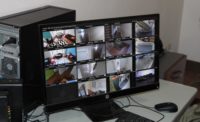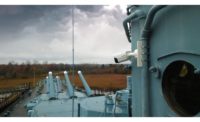
Portions of the TV series “Hotel,” based on the novel of the same name by Arthur Hailey, were filmed at The Fairmont in San Francisco, where the video security system was upgraded to DVRs.
Since its opening, every president since Taft (except George W. Bush) has stayed at The Fairmont, along with royalty, foreign heads of state, celebrities and Fortune 500 corporate executives.
The 591-room, four-star hotel is situated on a property that encompasses 1 million square feet – an entire city block. The main building is 10 stories high. The tower, added in 1962, is 29 stories tall, with a 24th floor function space that offers a 360-degree panoramic view of San Francisco Bay with a five-bridge view.
For such a vast property, a stringent security system is required to facilitate employee safety, asset protection and service to its many high-profile guests.
Microbiz Security Co., San Francisco, won the bid to install the first CCTV system in 1996, which consisted of a matrix switcher, time-lapse VHS recorders and multiplexers to monitor and record a variety and number of cameras.
When Perry Miller was promoted as The Fairmont’s new security director in 1999, he began to make changes to the original system to make it more effective. After the events of September 11, 2001, it became evident that a system upgrade was a top priority.
“We began to reposition cameras and make additions to the CCTV system,” Miller notes.
Later, as DVR technology progressed, Miller started researching products to replace the outmoded VCRs.
“We wanted to find the best fit for our hotel,” Miller explains. “I did a lot of research and talked to many people in hotels and sports complexes who used different manufacturers. I soon narrowed it down to Dedicated Micros’ DVRs.”
Miller was impressed with Dedicated Micros’ BX2 640GB DVR when he first saw it demonstrated at a trade show.

The lobby’s distinctive pillars help orient the view on the security monitor.
In April 2003, The Fairmont Hotel called upon Microbiz again to recommend CCTV equipment, based on the best service and product reliability, Chritton reports.
Miller went on location to observe several Dedicated Micros installations in action before making his final decision.
Upgrades included a Middle Atlantic Products Inc. security console to stack four networked Dedicated Micros BX2 CA 16-channel DVRs with 640GB of internal storage and CD burners.
The DVRs monitor more than 50 covert and overt cameras, including Sony color cameras, Pelco Legacy outdoor pan/tilts and Spectra 3 pan/tilt domes for the interior public spaces and restaurants.
The central security control room has keyboard controls with a Tatung call-up monitor and four Tatung 19-inch LCD flat screen monitors. The DVRs are networked so Miller can access the cameras from his remote office via his client computer. The matrix switcher supports eight monitor and keyboard outputs.
Miller’s remote office is equipped with a Pelco keyboard, joystick and a monitor so he can remotely access any camera on the network.
The covert elevator cameras are affixed discretely outside the elevator cabs, making them invisible from the cabs’ interior. Otis elevator ran the video cables to the elevator machine room along the traveler, a cable that is attached to the elevator cab and the machine room. It has a lot of cables attached, including those for the camera.
The system was a challenge to install because of the age of the hotel. The electrical closet starts in the basement. The conduit runs vertically through the floors from bottom to top, and cable in exposed locations had to be run through conduit.
“The riser closets do not line up because of the many nooks and crannies and solid ceiling areas, where it took more time to run cable,” Miller relates.
Some guesswork was needed because the blueprints for the hotel were hard to obtain, Todd Chritton, systems engineer at Microbiz reveals, but the engineering staff had been around a long time and was helpful in defining the cable routes.
“The path that you follow with the 4-inch conduit sleeve is daisy-chained, so that you can cut one floor off without affecting others,” Chritton explains. “But since the existing conduit was staggered, we often couldn’t tell where it ran.”
Because another vendor was already installing different low-voltage cabling for another system, Microbiz hired them to run the cable.

The lobby is visible on the security monitor in the hotel’s control room. The system was installed by Microbiz Security Co., San Francisco.
“Even with all the challenges, it was a great opportunity to work on such an old edifice,” Chritton says.
All plenum fire-rated wire was used, and coax and 18-2 conductor wires were installed from each camera location to the security console, Miller notes.
The camera data travels into the DVR and then loops out and terminates into the matrix switcher, which has a monitor output so security staff members can view each camera from their security control room.
Once the system was installed, Jay Bryant of Somerville Security Associates, the Dedicated Micros representative, trained several staff members in San Francisco. Bryant also assisted Microbiz with onsite training and provided support to the IT department.
The Fairmont’s security staff now monitors the cameras around the clock, and performs property guard tours.
“Additional improvements are an increased frame rate, higher resolution and the ability to simultaneously record multiple camera locations,” Miller says. “As well, the motion-based recording and the ability to view the cameras from any authorized computer on the network complete the spectrum of our needs.”
The hotel’s security staff has solved everything from locating misplaced bags to determining which vehicle damaged the loading docks’ rollup doors.
They have identified employee violations inside the building and potential insurance fraud cases, as well as supported local police with images of traffic accidents on the intersections that surround the hotel.
“We also had a group of gypsies who came through once and stole a piece of expensive luggage from the front entrance,” Miller relates. “We got good video footage of the incident, including close-up facial footage, as well as their brand new Mercedes. A police inspector on the fraud detail familiar with the gypsy community persuaded them that they had 24 hours to return the goods or face arrest, and they did.”
It is not enough to have the system, Miller declares. You also have to monitor it. “As events happen, you learn what to look for. You can burn a CD for each unique scenario and use it as a training tool for new security staff,” he says.
“If we observe any suspicious activity, we burn a CD,” Miller asserts. “In a week, we’ll burn five to six CDs. Images are e-mailed through a hotline network consisting of the San Francisco Hotel Security Director’s Association, that shares the images with member hotels as well as federal, state and local law enforcement agencies.”
Sidebar: On the Job
- Four Dedicated Micros BX2 CA 16-channel DVRs with 640GB of internal storage and CD burners
- Dedicated Micros KBS3 keyboard
- Middle Atlantic security console
- Sony color cameras
- Pelco Legacy outdoor pan/tilts
- Pelco KBD 300 keyboard
- Pelco Spectra 3 pan/tilt domes
- Tatung call-up monitor
- Four Tatung 19-inch LCD flat-screen monitors




